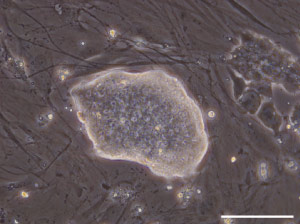Apr. 17, 2015 Research Highlight Biology
Culture clash for mouse stem cells
A particular protein pattern is essential to the success of a commonly used protocol for establishing mouse embryonic stem cells
 Figure 1: A rat embryonic stem cell (ESC) bearing signal transducer and activator of transcription 3 (STAT3) and cultured in leukemia inhibitory factor (LIF). Scale bar is 200 micrometers. Reproduced from Ref. 1 and licensed under CC-BY 3.0 © 2014 S. Ohtsuka & H. Niwa
Figure 1: A rat embryonic stem cell (ESC) bearing signal transducer and activator of transcription 3 (STAT3) and cultured in leukemia inhibitory factor (LIF). Scale bar is 200 micrometers. Reproduced from Ref. 1 and licensed under CC-BY 3.0 © 2014 S. Ohtsuka & H. Niwa
Only certain mouse strains are amenable to the establishment of mouse embryonic stem cells (ESCs) using a common laboratory protocol. Satoshi Ohtsuka and Hitoshi Niwa from the RIKEN Center for Developmental Biology have now discovered why1.
Early methods for deriving and maintaining mouse ESCs required that the culture medium include a protein called leukemia inhibitory factor (LIF), which is known to promote the undifferentiated ‘pluripotent’ state of ESCs by activating another protein — signal transducer and activator of transcription 3 (STAT3). Laboratory recipes involving LIF are still in use today, but they are only good for establishing stem cells from mice of particular genetic backgrounds. For other mice strains, newer protocols are needed. These usually still involve LIF, but they also demand the use of inhibitors against two other proteins: glycogen synthase kinase 3 (GSK3) and mitogen-activated protein kinase (MAPK).
To better understand why different strains call for different culture media, Ohtsuka and Niwa at the Laboratory for Pluripotent Stem Cell Studies compared the molecular signaling pathways downstream of LIF in mouse ESCs of various genetic backgrounds. The researchers exposed stem cell lines to LIF (Fig. 1) and then observed the greatest activation of the STAT3 pathway in ESCs derived from strains that can be cultured with LIF alone, and the highest levels of MAPK activity in ESCs from strains that cannot be maintained with LIF alone.
Rat ESCs, which must also be cultured with MAPK and GSK3 inhibitors for the protocol to work, displayed similar expression patterns to the mouse ESCs that require the same medium. According to Ohtsuka, it makes sense then that blocking MAPK is necessary to facilitate the culturing of ESCs taken from these particular mouse strains or from rats.
The researchers also identified another way to promote ESC establishment. They took mouse ESCs that normally require MAPK inhibition and added a molecule called 4-hydroxytamoxifen, which activates a hormone-inducible form of STAT3 called STAT3ER. With both inducers, the ESCs could self-renew and maintain their pluripotency. These cells, with heightened STAT3 activity induced by STAT3ER, showed natural repression of the MAPK pathway.
“Our results suggest that the balance between the STAT3 and MAPK pathways may be one of the crucial signatures that determine the self-renewal capacity of mouse ESCs in various contexts,” says Ohtsuka. “We are now studying the next important question of how the genetic background determines the signaling balance of pluripotency in all animals, including humans.”
References
- 1. Ohtsuka, S. & Niwa, H. The differential activation of intracellular signaling pathways confers the permissiveness of embryonic stem cell derivation from different mouse strains. Development 142, 431–437 (2015). doi: 10.1242/dev.112375
